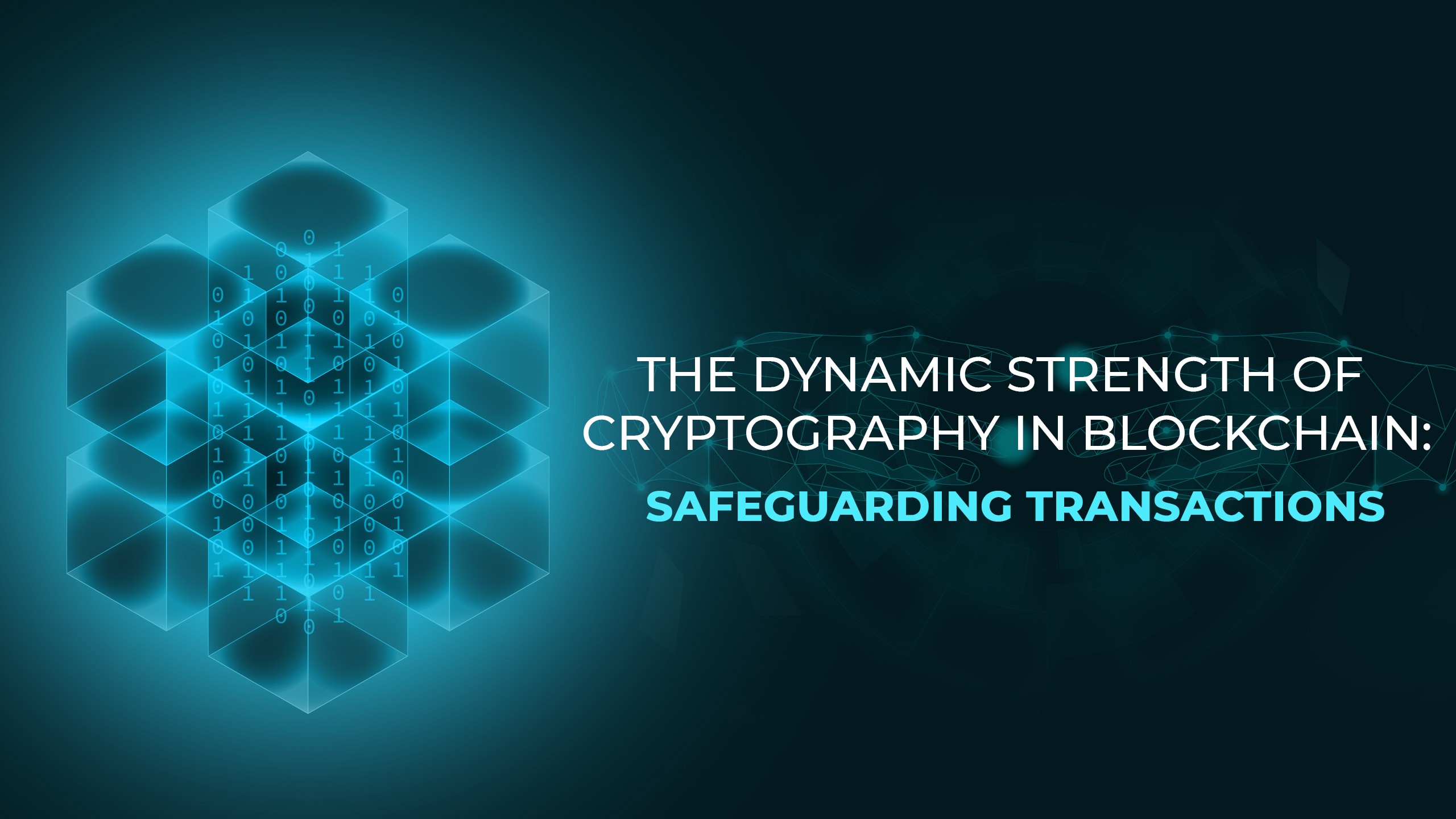Introduction
Cryptography in blockchain stands as a transformative force reshaping transaction handling and data security. At its heart, blockchain is an intricately designed, decentralized, and distributed ledger, guaranteeing transparency, immutability, and security. A closer inspection into the inner workings of this technology reveals that cryptography in blockchain plays a pivotal role in crafting its security landscape.
Blockchain Technology
Blockchain, in its essence, is a chain of blocks containing data, where each block is linked to the previous one through a cryptographic hash. This decentralized structure eliminates the need for a central authority, providing a tamper-resistant and trustworthy system.
Importance Of Security In Blockchain Transactions
Security is paramount in the world of blockchain. The decentralized nature of the technology doesn’t mean it’s immune to threats. Instead, it relies on robust security measures, and cryptography plays a pivotal role in fortifying these digital transactions.
Role Of Cryptography In Blockchain
Cryptographic techniques form the backbone of blockchain security. From securing transactions to ensuring the integrity of data, cryptography is the guardian of the decentralized realm. In the following sections, we’ll unravel the basics of cryptography, exploring its various facets in the context of blockchain technology.
Basics of Cryptography
Cryptographic Techniques
Cryptography in blockchain involves a myriad of techniques that encode information to safeguard it from unauthorized access. Encryption algorithms, key management, and secure communication protocols are integral components, of ensuring the confidentiality and integrity of data.
Public And Private Key Concepts
At the heart of cryptography lie the concepts of public and private keys. These key pairs form the foundation of secure communication and transaction validation. The public key, known to all, allows for data encryption, while the private key, kept confidential, is used for decryption and digital signatures, ensuring the authenticity of transactions.
Hash Functions In Blockchain
Hash functions play a crucial role in the integrity of blockchain data. These one-way mathematical algorithms generate unique identifiers for each block, creating a digital fingerprint. Cryptography in the blockchain utilizes hash functions to link blocks, ensuring the immutability of the entire chain.
Security in Blockchain Transactions
How Cryptography Ensures Transaction Security
The essence of cryptography in blockchain lies in its ability to secure transactions through advanced cryptographic techniques. It ensures that data exchanges within the decentralized network remain confidential and resistant to tampering.
Digital Signatures And Their Role
Digital signatures, a cornerstone of cryptography in blockchain, serve as virtual fingerprints, validating the authenticity of transactions. Each participant possesses a unique private key, enabling them to sign transactions digitally. This process not only ensures the integrity of the data but also verifies the identity of the parties involved.
Encryption In Protecting Data On The Blockchain
The safeguarding of sensitive data is a priority in blockchain, and cryptography achieves this through encryption. By converting plain text into complex codes that can only be deciphered with the appropriate keys, encryption adds an extra layer of protection, preventing unauthorized access.
Cryptography and Consensus Mechanisms
As we navigate the intricacies of blockchain, the synergy between cryptography and consensus mechanisms becomes a cornerstone in ensuring the trustworthiness of the decentralized network.
Overview Of Consensus Algorithms
Consensus algorithms form the backbone of blockchain, determining how agreement is reached among nodes in the network. Cryptography in blockchain plays a vital role in these algorithms, ensuring the security and validity of transactions.
Role Of Cryptography In Achieving Consensus
The decentralized nature of blockchain relies on consensus mechanisms to validate and add transactions to the distributed ledger. Cryptographic principles, such as proof of ownership and cryptographic puzzles, are employed to establish agreement among nodes, enhancing the security and reliability of the consensus process.
Examples Like Proof Of Work And Proof Of Stake
Two prominent examples showcasing the marriage of cryptography and consensus mechanisms are Proof of Work (PoW) and Proof of Stake (PoS). PoW utilizes cryptographic puzzles to validate transactions, while PoS relies on ownership and stake, both rooted in cryptographic principles, to achieve consensus.
Challenges and Innovations
In the dynamic landscape of blockchain, the interplay of cryptography presents both challenges and sparks continuous innovations, shaping the evolution of secure decentralized transactions.
Common Challenges In Blockchain Security
Cryptography in blockchain faces challenges ranging from potential quantum computing threats to the need for ongoing advancements in cryptographic protocols. Balancing the demand for increased security with the necessity for efficiency poses a continuous challenge in the ever-evolving world of decentralized technology.
Ongoing Innovations In Cryptographic Techniques
To counter challenges, the realm of cryptography in blockchain witnesses a constant stream of innovations. Researchers and developers actively explore new cryptographic techniques, such as post-quantum cryptography, to stay ahead of potential threats and enhance the security features of blockchain.
Future Trends In Blockchain Security
Looking forward, the future of cryptography in blockchain holds exciting possibilities. Quantum-resistant algorithms, improved privacy-focused cryptographic methods, and novel consensus mechanisms are anticipated to redefine the security landscape, ensuring the continued resilience of blockchain technology.
Conclusion
In the realm of blockchain, the symphony of cryptography orchestrates a secure and decentralized network that has redefined the landscape of digital transactions. As we reflect on the journey through the intricacies of cryptography in blockchain, a resounding theme emerges – the crucial role played by cryptographic principles in ensuring transparency, integrity, and security.
Also, discover the diverse range of blockchain applications we’ve developed. Explore our portfolio to see how our expertise can elevate your project with our blockchain application development services.
FAQs
1. How does cryptography ensure the security of transactions on the blockchain?
- Cryptography in blockchain employs advanced techniques such as encryption, digital signatures, and hash functions. Encryption safeguards the confidentiality of data, digital signatures verify transaction authenticity, and hash functions ensure the integrity of the entire blockchain.
2. What is the significance of public and private keys in cryptography in blockchain?
- Public and private keys form the foundation of secure communication in blockchain. The public key allows for data encryption, while the private key, kept confidential, is used for decryption and digital signatures. This key pair ensures secure and authenticated transactions.
3. How does cryptography play a role in achieving consensus in blockchain?
- Cryptography is integral to consensus mechanisms in the blockchain. It establishes agreement among nodes through cryptographic principles like proof of ownership and cryptographic puzzles. This ensures that transactions are valid, secure, and agreed upon by the decentralized network
4. What are the challenges faced by cryptography in blockchain security?
- Challenges include potential threats from quantum computing and the ongoing need for advancements in cryptographic protocols. Balancing security and efficiency poses a continuous challenge in the dynamic world of decentralized technology.
5. What are the future trends in cryptography for blockchain security?
- The future holds exciting possibilities, with ongoing innovations in quantum-resistant algorithms, privacy-focused cryptographic methods, and novel consensus mechanisms. These trends aim to enhance the security and resilience of blockchain technology against emerging threats.






